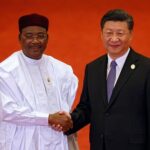We decided to lean towards our wellness objective in this blog post. For many who moved to the Diaspora at a young age such as me at the age of 12, we are limited in our knowledge of Nigeria’s history for obvious reasons. However, there are increasingly more resources and information online to help fill the knowledge gap. Below are some pictorial illustrations that capture important periods in Nigeria’s history.

A colonial officer being carried by his servants in Lagos in 1910 during the British colonial era

British Ad of the Exhibition at Wembley of their then youngest colony, Nigeria. The world came to Wembley in 1924 for the British Empire Exhibition. Its objective was to promote trade and help citizens from the countries of what is now the Commonwealth to get to know each other. Credit: Times of London

Ankle plates were a main part of female costume among the Igbos. The women wore them permanently. Lady pictured in 1913

Then Emir of Katsina and his entourage admiring Hyde Park Traffic Lights in London in May 1933. Credit Getty Images

A Village Court in Uyo in 1949; a Colonial District Officer presides aided by his interpreter. Source: Bimbola Babarinde

Then Alake of Egbaland, Oba Ladapo Ademola II attending the coronation of King George VI of England. London, May 1937

Queen Elizabeth II rides in her 1952 Rolls-Royce during her first visit to Nigeria in 1956, her visit was received with lots of fanfare and royal services

Tokunbo, Obafemi Awolowo’s daughter, presents a bouquet of flowers to Queen Elizabeth in Ibadan in 1956

Before the civil war, President Gowon and Ojukwu, Head of Biafra sharing a meal in Ghana for peace talks in January 1967, hoping to prevent the civil war, unfortunately, they were not able to prevent the inevitable

Volunteers for the Biafran army, at a militia training center in Okigwein in 1968, unfortunately, many of these men lost their lives. Credit Life Magazine

In 1969, during the civil war, President Gowon married Ms. Victoria Zakari. Many considered it distasteful considering the war climate at the time.

British businessmen John Downing, a tractor company salesman, and William Blakeley, a marine manager, are held prisoners after being captured by Nigerian Federal Troops during the Biafran war, circa 1968. Credit: Hulton-Deutsch Collection/Corbis

Nigerians in Lagos celebrate the end of the Nigerian Civil War on January 12, 1970. Credit Getty Images

Poster developed by the British, thanking Nigeria for supplying groundnut during WW2 to help feed the British Army. Source: Hoover Institution

Nigerians who raised money for England to buy weapons in WW2 were given Kill Hitler Certificates, Circa 1941. Credit: Bee News

4-time Grammy Award Winner, Sade Adu (being carried by her dad-Adebisi Adu) with her mom and brother in Ibadan, Circa 1959

Left to Right; Miss Tanzania, Miss Uganda, Rosalind Balogun (Nigeria’s 1st Miss World Contestant) and Miss Ghana at 1967 Miss World Beauty Contest

Pope John Paul II on his way to mass at Onitsha in 1982

In 1976, when £1 = N1.15, #GoodOldDays. Now £1 = N487 #GodHelpUs

Then US President, Carter and wife with Shagari greeting cheering crowd from the White House balcony in 1980

Part of Nigeria’s ugly history, in 1983, Nigeria’s President expelled two million undocumented West Africans, most of whom were from Ghana. They were blamed for the economic crisis in the country; until today in Nigeria, these bags are still called Ghana Must Go bags. Credit BBC

Founded in 1958, Nigerian Airways served both domestic and international destinations mainly concentrated in West Africa; the network also had points in Europe, North America and Saudi Arabia. Plagued by mismanagement and corruption, Nigerian Airways ceased operations in 2003.

The Late Princess Diana, Princess of Wales, toured Nigeria in 1990

Winner of 1993 Presidential election, MKO Abiola in 1994 arriving at his first appearance in court. He was instead charged with treason and later died in captivity. Credit Getty Images


